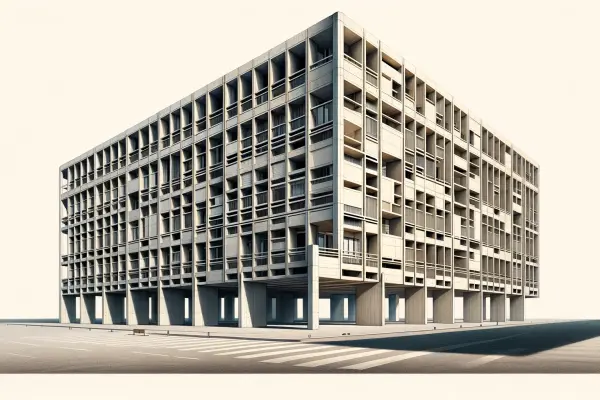Brutalism — a unique direction in 20th century architecture that fundamentally changed the appearance of cities and had an enormous influence on the development of world architecture. In this article, we will examine in detail the history of brutalist architecture's origins, the key features of this architectural style, the most famous brutalist buildings, and also analyze the criticism and modern revival of this movement in architecture.
The Emergence and History of Brutalism in Architecture
After the massive destruction of World War II, Europe experienced an acute shortage of housing and public buildings. This created a need for fast and inexpensive construction, which became one of the catalysts for the development of architectural modernism. Architects began actively using concrete in architecture, glass, and other industrial materials to create functional buildings.
"Architecture — is a skillful, precise, and magnificent play of volumes assembled together under light. Brutalism strives to show the truth of materials, their honesty and authenticity," — wrote Le Corbusier, one of the founders of modern architecture and the brutalist movement.
The famous architect Le Corbusier characterized such buildings as "brutal" (from the French "béton brut" — raw concrete), which gave the name to the new architectural style. According to research on the history of brutalism, it was Le Corbusier's works, especially his Marseille Housing Unit, that laid the foundations for the aesthetic philosophy of this movement. The first significant buildings in the brutalist style appeared in the mid-20th century, with the peak of brutalist architecture's popularity occurring in the 1950s-1970s.
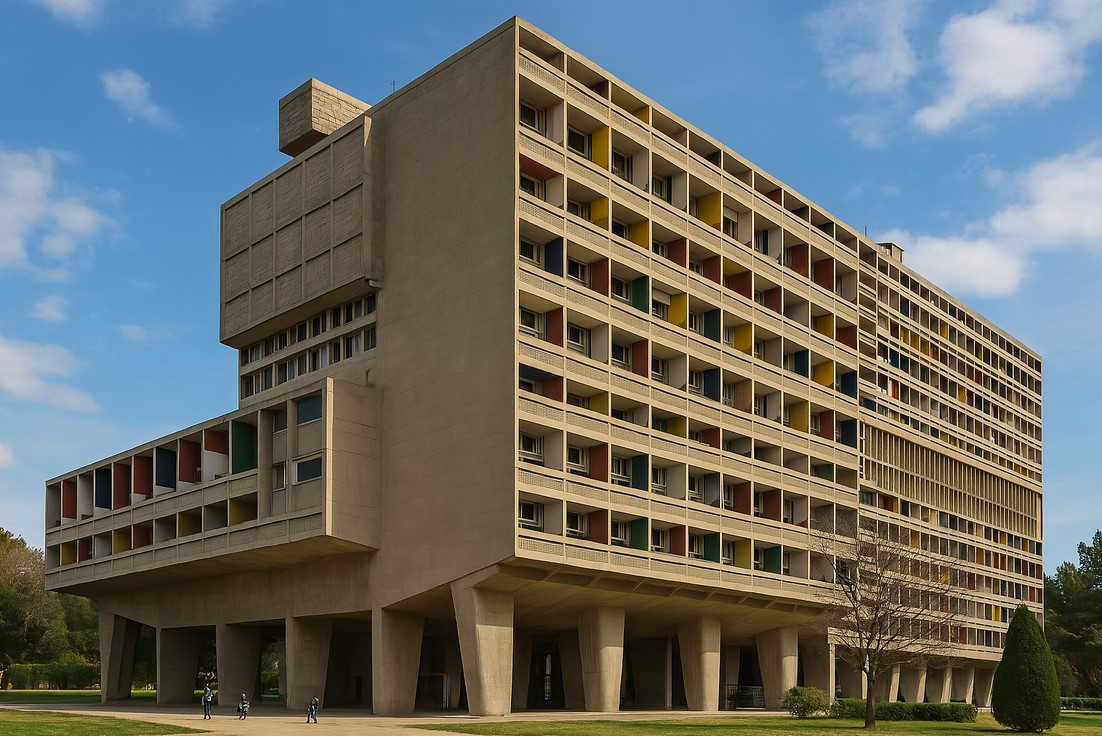
Distinctive Features of Brutalist Architecture
The brutalist style in architecture has a number of characteristic features that make it recognizable and distinguish it from other architectural movements:
- Raw concrete — architects deliberately emphasize the texture of the materials used, most often rough concrete or brickwork, not hiding them under plaster and facing panels.
- Monumentality of structures — laconic, austere, angular forms dominating over decoration, where functional design is more important than aesthetics.
- Modular architecture — the use of standard elements (panels, beams) to increase the speed and economy of architectural construction.
- Geometric building forms — the use of clear lines, right angles, and massive blocks in architectural composition.
- Large glazing surfaces — facades with large-scale glazing, enhancing the expressiveness of brutalist buildings.
- Minimalism in architecture — absence of decorative elements and ornaments, emphasis on structure and form.
- Rough texture — deliberate preservation and emphasis of formwork marks on concrete, creating a characteristic surface relief.
These characteristics of brutalist structures create a unique visual impression that often evokes contradictory feelings in viewers. Despite their somewhat rough appearance, brutalist buildings possess a certain strength and power. They symbolize honesty and directness in architecture, where functionality and simplicity are of primary importance.
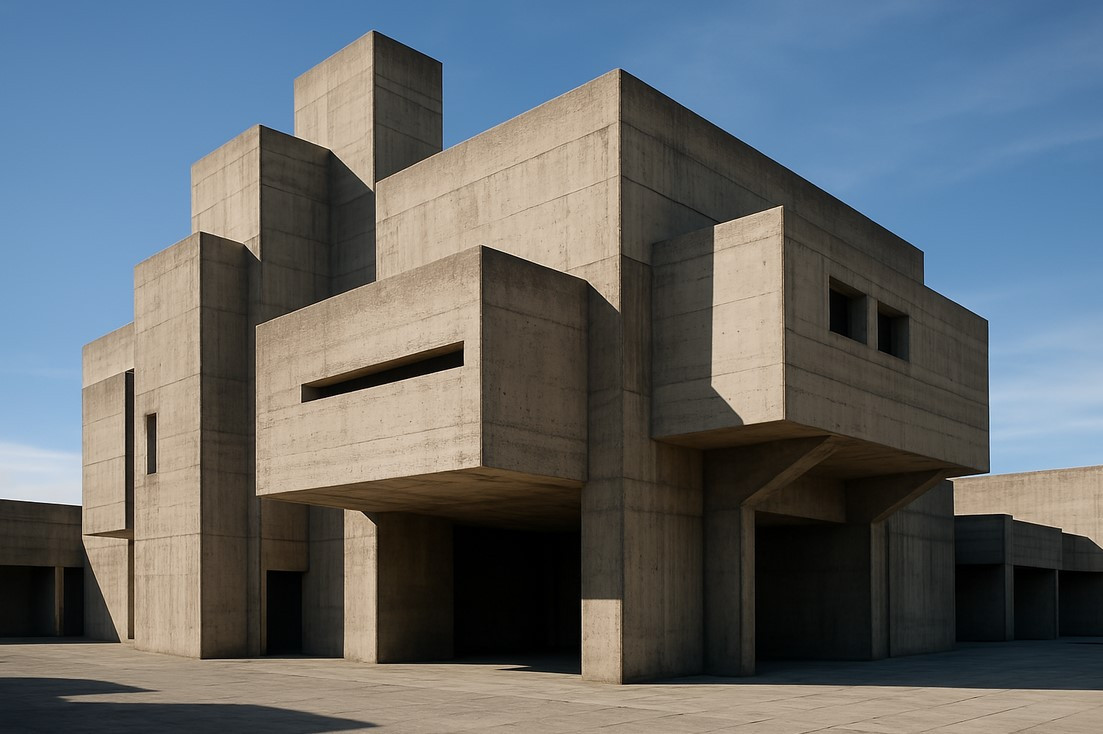
| Characteristic | Brutalism | Modernism | Postmodernism |
|---|---|---|---|
| Main materials | Concrete with visible texture, brick | Glass, steel, concrete | Various materials |
| Approach to form | Massiveness, monumentality | Lightness, "floating" volumes | Playing with form, eclecticism |
| Decorativeness | Minimal, emphasis on rough texture | Absent, "form follows function" | Active use of decoration |
| Social orientation | Often for social housing, public buildings | Universal architecture | Often commercial architecture |
| Peak period | 1950s-1970s | 1920s-1950s | 1970s-1990s |
This table clearly demonstrates how brutalist architecture fits into the overall picture of 20th century architectural style development, while maintaining its unique characteristics and approach to form creation.
Striking Examples of Brutalism in World Architecture
Brutalist architecture is represented by many outstanding buildings around the world. Let's look at the most striking and famous examples of brutalist architecture:
Iconic Brutalist Buildings in Europe and America
- Unité d'Habitation Residential Complex in Marseille — designed by the great Le Corbusier in 1952, this residential quarter on thin concrete pilotis raises the buildings above the ground. The facades are distinguished by simple strict lines, ribbon glazing, and the absence of decoration.
- The National Theatre Building in Mannheim by architect CG Baumhauer — its facade with a powerful framework of concrete columns and ceilings and huge glazing creates a sense of monumentality and laconicism.
- Boston City Hall — an inverted stepped pyramid built by architects Kallmann, McKinnell, and Knowles. Staircase spans encircle the entire structure, creating a play of light and shadow on the facades.
- "Habitat 67" in Montreal — a residential complex designed by architect Moshe Safdie for the "Expo-67" exhibition, consists of modular blocks creating a unique architectural composition.
- Geisel Library at the University of California — built in 1970 according to William Pereira's design, it became a symbol of brutalist architecture with expressive forms.
- The Barbican Centre in London — a massive residential and cultural complex built between 1965 and 1976, is one of the most significant examples of brutalism in Great Britain.
Brutalist Architecture in Ukraine
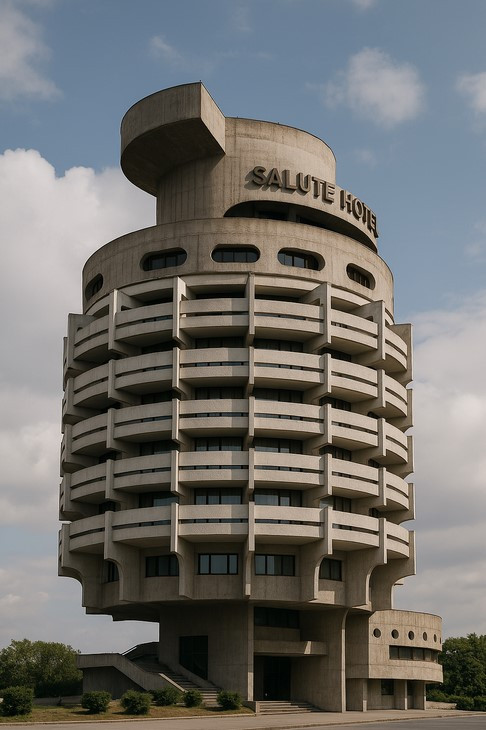 Ukraine possesses an impressive heritage of brutalist architecture that deserves special attention. These monumental structures are not just buildings — they are witnesses to an era, unique embodiments of architectural thought:
Ukraine possesses an impressive heritage of brutalist architecture that deserves special attention. These monumental structures are not just buildings — they are witnesses to an era, unique embodiments of architectural thought:
- Hotel "Salute" in Kyiv (1984) — a futuristic cylindrical building designed by architect Avraam Miletsky. This unusual 16-story elliptical construction creates a stunning visual effect thanks to its non-standard geometry. Initially, a taller structure was planned, but its height was reduced to avoid competing with the city's historical dominants.
- Kyiv Crematorium (1975) — an outstanding example of architectural modernism created by architects Avraam Miletsky, Ada Rybachuk, and Vladimir Melnichenko. The complex includes a columbarium, Memory Wall, and an administrative building with characteristic concrete forms. This object is considered one of the most emotionally expressive embodiments of functionality in the brutalist style.
- National Library of Ukraine named after V.I. Vernadsky (1989) — a monumental structure embodying industrial style and a functional approach to space organization. The massive concrete structures of the building create an atmosphere of strength and reliability characteristic of brutalism.
"Each building in the brutalist style — is not just a concrete construction, but a manifesto of the philosophy of honesty in architecture. This is where its enduring value for modern urbanism lies," — notes Professor of Architecture Thomas Bilstein.
As noted in the review of the best examples of brutalist architecture in the world, this style spread to almost all continents, acquiring regional features and embodiments. Each region brought its unique characteristics to brutalist architecture, adapting general principles to the local context.
The Modern Revival of Brutalism
A Success Story: From Rejection to Recognition
When in 2015 the international architectural bureau MVRDV received a commission to reconstruct the brutalist Y-Block building in Oslo, many expected the firm to propose a radical transformation of the "outdated" structure. However, the team of architects led by Winy Maas made an unexpected decision. "We saw in this building not just a concrete box, but a part of cultural heritage, a valuable example of architectural modernism that should be preserved and emphasized," — Maas later recounted. Instead of demolition or radical reconstruction, MVRDV proposed careful restoration of the concrete facades, preservation of original architectural elements, and minimalist modern additions that do not disrupt the integrity of the brutalist architecture. The project received international recognition and became a turning point in attitudes toward brutalism, demonstrating that brutalist buildings can be adapted to modern requirements without losing their architectural identity.
Neo-brutalism: Contemporary Interpretations of the Classic Style
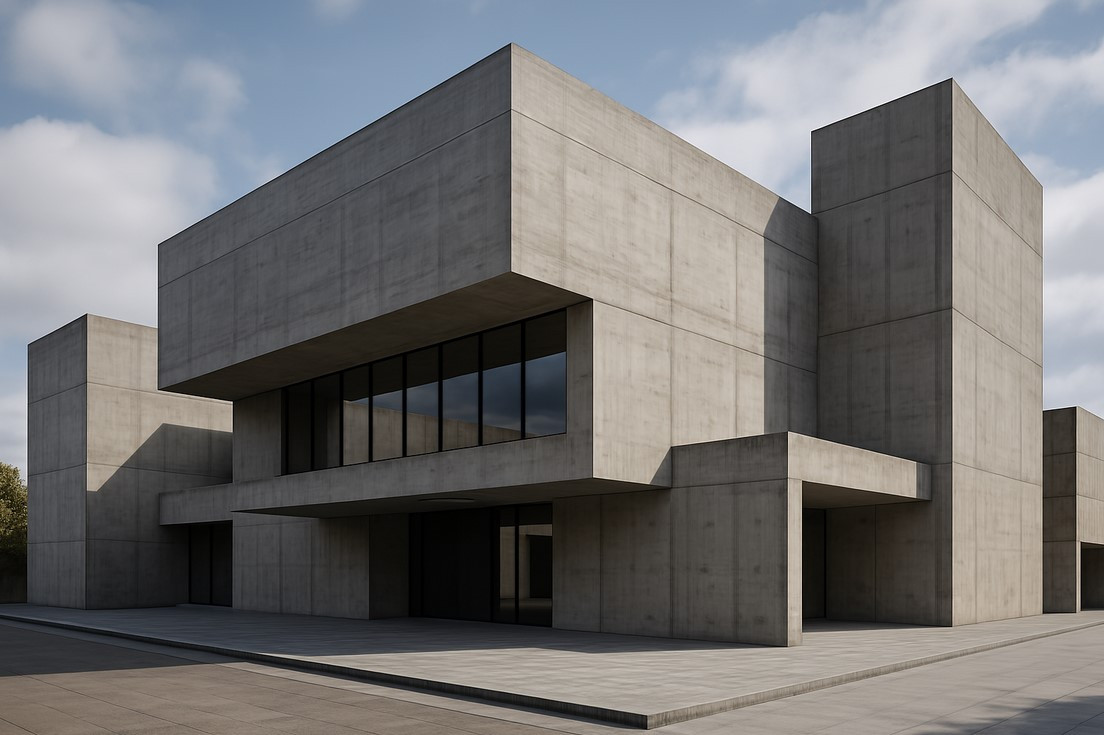 In the last decade, we have witnessed a true renaissance of brutalist aesthetics in contemporary architecture. A new generation of architects is rethinking the heritage of brutalism, creating stunning modern structures that preserve the spirit of the original style but use innovative technologies and materials:
In the last decade, we have witnessed a true renaissance of brutalist aesthetics in contemporary architecture. A new generation of architects is rethinking the heritage of brutalism, creating stunning modern structures that preserve the spirit of the original style but use innovative technologies and materials:
- Teshima Art Museum (Japan, 2010) by architect Ryue Nishizawa — a minimalist concrete building with organic forms, demonstrating how modern technologies allow overcoming the rigid geometry of classical brutalism.
- Garage Museum of Contemporary Art (Moscow, 2015) — Rem Koolhaas's project to reconstruct a Soviet brutalist building, where concrete with visible texture combines with modern materials.
- National Museum of Qatar (Doha, 2019) by Jean Nouvel — although not pure brutalism, it demonstrates the use of massive concrete forms in a contemporary interpretation.
These exciting projects prove that the geometric forms of buildings and monumentality of structures characteristic of the brutalist movement can be relevant today, evoking admiration from new generations of architects and art appreciators. Many tourism companies even organize special tours of brutalist buildings in cities around the world, and photographs of brutalist-style buildings have become a popular element in interior collections and architectural posters.
Criticism of the Style and Its Influence on Modern Architecture
Despite its innovation, brutalist architecture did not escape serious criticism. Brutalist architecture was criticized for excessive asceticism, disregard for human scale, and insufficient attention to the aesthetic component. Many critics noted that massive concrete buildings create an oppressive atmosphere, and urbanism in the brutalist style can negatively affect the psychological state of residents.
Renowned architectural critic Charles Jencks in his book "The Language of Post-Modern Architecture" (1977) called the brutalist movement "an unsuccessful attempt to create a new monumentality," pointing to the dehumanizing effect of these buildings. Jane Jacobs, author of the influential work "The Death and Life of Great American Cities," criticized brutalist complexes for creating unattractive urban spaces that residents tried to avoid.
However, in recent years, there has been a striking revival of interest in brutalist architecture. Modern architects are rethinking the heritage of brutalist buildings, adapting their principles to current ecological and aesthetic requirements. Concrete modernism and industrial style in interior and exterior building design often draw inspiration from brutalist architecture.
"Brutalism is returning, but in a new quality. Modern architects have learned to combine the power of concrete with visible texture with environmental friendliness and comfort. It is no longer the monumental style of the mid-20th century, but its rethought version," — believes architectural critic Rainer Bantam.
For those who want to delve deeper into the world of brutalist architecture, there are several excellent publications. The book "Atlas of Brutalism" (Phaidon Press, 2020) presents the most comprehensive study of this style with more than 850 buildings from around the world. "SOS Brutalism: Saving Concrete Treasures" (Park Books, 2022) not only tells the history of the style but also raises questions about protecting brutalist heritage. For a deeper understanding of the style's philosophy, "Concrete Concept: Brutalism and Housing" by Adrian Forty is recommended.
Today, the principles of the brutalist movement find application in the creations of many contemporary architects, such as Tadao Ando, Peter Zumthor, and David Chipperfield. Minimalism in architecture, honesty of materials, and functional design — these ideas of this architectural style remain relevant in the 21st century.
Conclusion
Thus, brutalism — is truly a captivating and significant architectural style of the 20th century that had an enormous influence on the development of modern architecture. Brutalist architecture is characterized by laconic forms, exposed textured surfaces of raw concrete, a tendency toward functionality of buildings, and impressive monumentality of structures. This style — is not just an architectural movement, but a genuine cultural phenomenon that continues to evoke strong emotions in viewers: from admiration to rejection.
Architectural modernism, of which brutalism is a part, radically changed the appearance of our cities and laid the foundations for the further development of architectural thought. Today, when industrial style and minimalism in architecture are again at the peak of popularity, it is worth rediscovering the impressive heritage of brutalist architecture and rethinking its significance for modern urbanism and our daily lives. Majestic concrete colossi — are not relics of the past, but inspiring beacons of the future, pointing the way to honesty, functionality, and emotional power in architecture.
